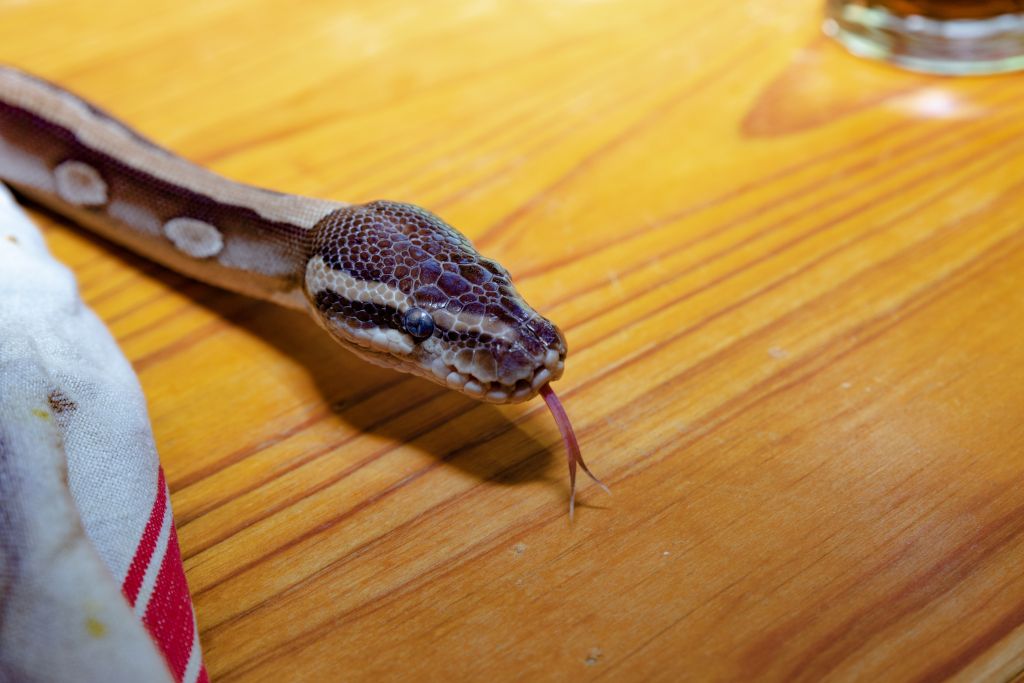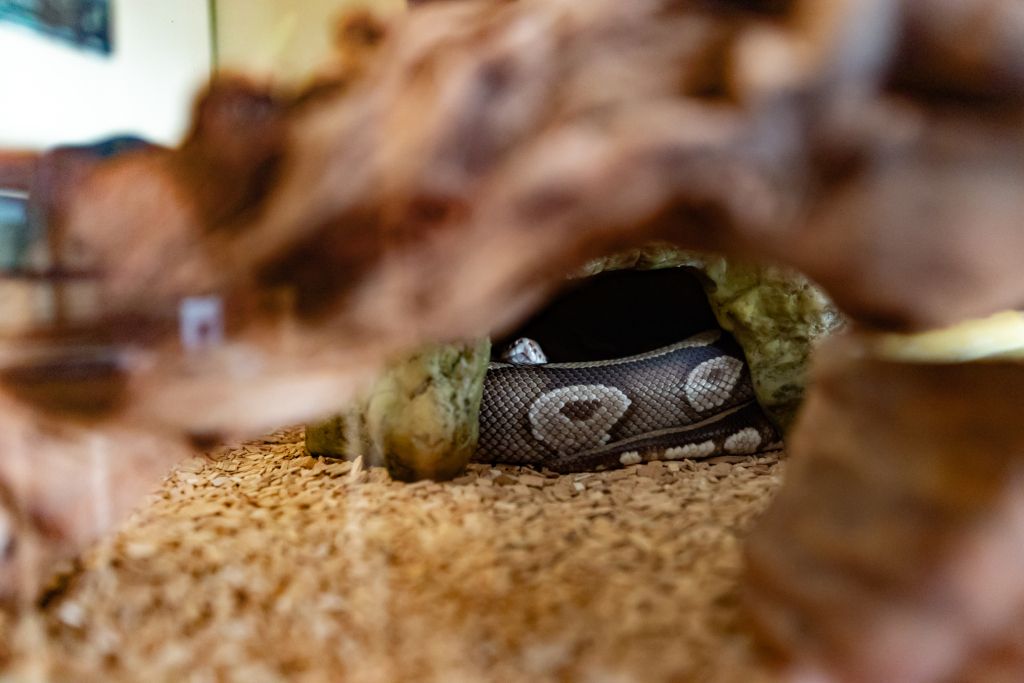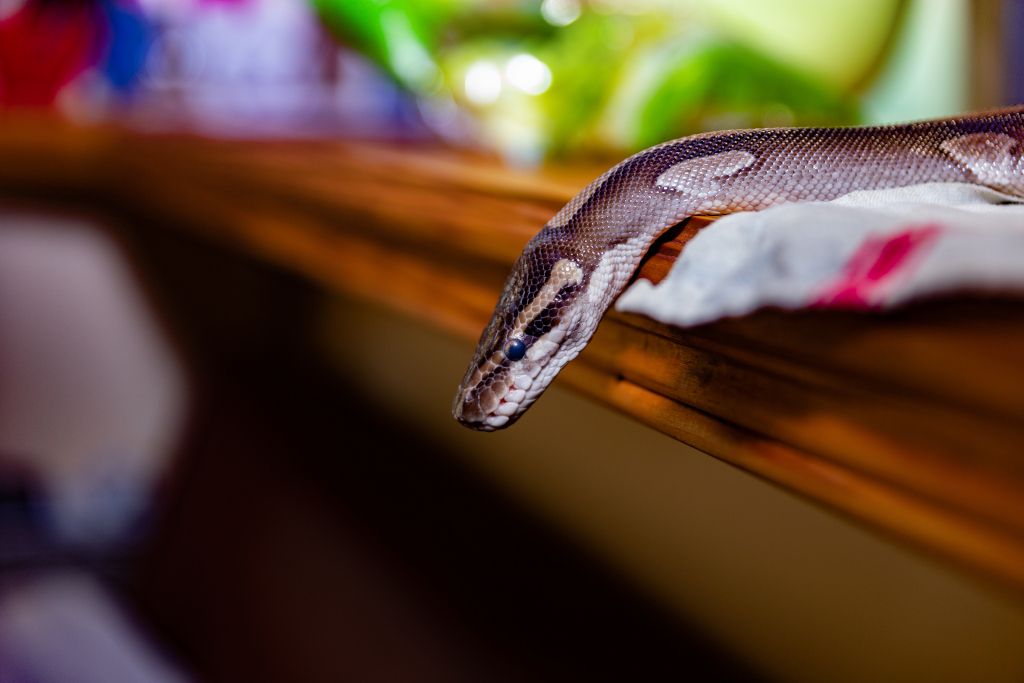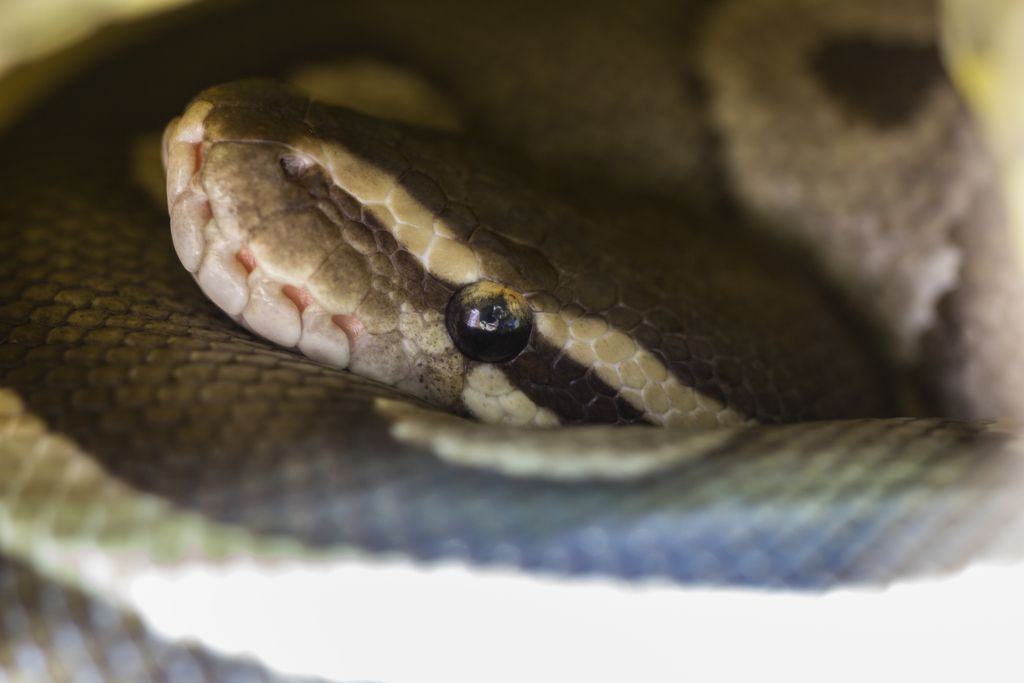Introducing my ball python
Here are some more informations about my ball python, Mojave morph.
Ball Python ? Strange name isn't it ?
Ball Pythons, because when they fear, they surround their head with their own body to hide and feel secure. So cute. They are also called Royal pythons.

They are .... Pythons yes.
As a reminder, pythons are constrictor snakes that don't own fangs nor venom at all. They got several dozen of small teeth that don't hurt a lot when used on you (but like for a dog, a bite from an adult size specimen is always a bad experience).
What to know about ball pythons ?
Well the Web is full of informations, really. I don't want to repeat such informations, so I will provide some infos but sometimes won't detail some others about such snakes. I will show here what I myself noticed with my own ball python snake, Mojave, male, about 6 years old.
Ball Pythons probably are the snakes with the largest morph list you can find. Amazing, every taste can be satisfied ! There even exists databases dedicated to them, have a look at http://www.worldofballpythons.com/morphs for example.

The morph I own is "Mojave". The price of the snake will depend mainly on the morph you choose. Ball pythons are usually not expensive snakes but some morphs can price high.
Ball pythons are this kind of snake very common, very reproduced around the world, and well mastered/understood. Ball pythons reach between 1 and 2 meters long once adult, never more. Depending on how you feed it, the ball python usually weights around 2-3 Kg while adult, big ones can reach 4 to 5Kg or even more (not recommended for its health though). Ball pythons are equipped very powerful and sensitive heat sensors around their mouth : they can feel a pretty tiny change in temperature in front of them, and around their head. That includes your own hand, which is hot compared to the snake.

A cool snake ?
Absolutely, some people recommend it for beginners. This snake very uncommonly bites. But biting is just a defensive or offensive way of expressing its mood, nothing more. It is not very hard to read a snake mood, that's something you learn with experience, video tutorials or training with pros.
Ball pythons are known to be especially feeling insecure and hide a lot, very rarely bite. Young snakes always bite more than adults, because they don't know you. Bites from young ball pythons are nothing. Once more it is easy to know if the snake is in "bite mode", and how to react to that : not complicated.
Ball pythons are cool snakes but mentally fragile : they often feel more scared than other snakes: you'd better move slowly, have cool and confident movements, approach them from behind and not from front. Those animals are pretty cute : they just fear your big-sized body compared to theirs, that's all ! Be cool and appreciate this animal for what it is.
A fragile snake
Like I said : ball pythons are especially apprehensive. You will need to comfort them when handling them. Like always with snakes : As soon as they don' t see you as a threat any more, they relax, and start exploring and moving.
Ball python is not for nervous people IMO, you must feel calm and confident when you handle them, and transmit your good mood to them.
If you shake, if you tense, if you don't rightly measure your own power while handling a ball python : it is not good. Once more : they rarely bite but can tense their body to express some stress : you see and feel the snake mood : it's not hard.
Then, a ball python is not more fragile that another snake : it is robust and strong.
The problem of their fear can show when in need to feed them. If the snake doesn't feel confident : it will refuse to eat, and you'll start experimenting some problems. Especially young ball pythons could harm themselves by refusing to eat until their own death, just, because of not feeling perfectly secure ... Sad situations (but rare, let's say it).
Put your ball python into its required enclosure, and mind to have it in a room in calm : no children (or other pets like dogs) should be able to hit the enclosure, no strong sound (music) should play and make the enclosure vibrate. This animal likes calm situations and needs some spots to hide. This animal feels vibrations (very tiny onces as well) through its body and skeleton : it is how he ears : non-stopping vibrations will most likely harm the snake. So under normal situations : it will feel safe.
I remind as well that any snake needs you to provide it some heat. You'll need heat power sources and thermostat, at any time. Get some more infos if needed.
A calm, docile and nocturnal snake
Once your ball python starts getting used to you and its environment, it will start feeling trusty and everything will be all right. Ball pythons are like every pythons : nocturnal animals, that means that you will barely see them during daylight.
All a ball python does during daylight is sleeping, hidden :-D
Remember that snakes don't own eyelid, so you cannot be sure it is sleeping while looking at it, that's why you want to approach it gently and not too brutally.
Once at night, and especially during summer, ball pythons move a lot. They move, they climb, etc... Remember that they may also be chasing, so if you want to handle your snake by night as you see it active : take care to alert it you are here as it may confuse your hand with food : which scenario you'll want to prevent ;-) Once more, correct body language reading tells you if the snake is in chase mode or not.
I sometimes handle mine at night, sometimes at day. I can feel the difference : during day, I almost always grab my snake as he is in sleep (no movement, or very very slow : clearly waking him up). At night I must warn him about my presence, then I grab him and he is much more excited in hands.
However, ball pythons are not speedy snakes. Even when fully awaken : they usually move slowly compared to other species that are much much more nervous and speedy while in your hands. Also, they don't climb a lot and if they do , you must take care they don't fall (from too high) as they are .... not very agile, they are ground snakes with a big body that is heavy and not especially agile.
You should take care not to let it fall on the ground from too high. Snakes have a lot of bones, look at that :

So you don't want your ball python to fall on a hard surface from too high as it may break part of its skeleton which would be a dramatic situation.
Take care as I noticed ball pythons are not that agile snakes : they can face barely any situation but ... don't push the limits too far if a high-distance fall may happen.
Ball Python manipulations
So like I said in the general-purpose introduction article, you don't keep snakes as pet to handle them every second.
You won't manipulate your snake if he is digesting. An adult ball python takes about 3 days to digest : don't touch it for this period. Same for shedding : It is not recommended to handle a snake in shed because of his bad view at this period, and because shedding is hard for them to support.

But ... I did that, "not recommended" doesn't mean DO NOT. There exists some general rules to follow, and then your own brain with your own snakes : making your own experience.
I helped my snakes shed a lot of time, it is a pure moment to feel. I could feel that the animal appreciated my help.
So ... It's all about you and your snake right ? For myself, it happens sometimes I don't manipulate my ball python for one full week - and at the opposite - sometimes I find myself having fun touching him every single day.
Always respect : Ball pythons don't bite. They can say "mmm leave me alone, but I'm still cool ya !" : so even if he says no, by hissing for example : I go and gently get him. It works, he knows what happens.
Respect means : be calm, don't force the snake : undertake it gently. Scratch it before undertake so that he knows you are here, etc... Snake manipulation is something in itself, once more not hard but it can take some time to master. A communication between you and the animal : always use mastered slow movements.
I myself have the snake feeling, I mean I learnt a lot with professionals (trainings), with Internet videos (from professionals), and with my experience with my snakes. Reading a snake is not that hard, knowing how to manipulate it neither, especially very cool species like ball pythons are really not a problem at all !
Also, remember that a snake with health problems, or a female hatching eggs : will show defensive behaviors.
Generally, on an average : I leave my snakes alone ! If I grab my python, it is for about 10 minutes : he does whatever he wants, on the sofa, on the kitchen table, etc... but I always have a look at him. Sometimes I keep him in hands, or around my neck to be hand-free, etc...

I always take care of the ambiant temperature : in winter I barely take my python out, but I appreciate long sessions (about 30min) in summer : their natural weither ;-)
Keep the temperature in mind when you manipulate your ball python out of its enclosure : if ambiant temp. is <=20°C, it's not good : keep the snake around your body (neck) for it to grab your own heat. If ambiant temp. is around >=23°C, you may leave the snake freely for a short period of time, always keep an eye on it because... You will see ;-) And during summer with ambiant temp. around the snake comfortable range, that means between 25-30°C -> enjoy.
You can feel the snake temp by simply touching it. Remember that your external hands skin is around ~30°C, so a 26°C snake body into your hands will feel medium and a 22°C snake body into your hands will feel like a very cold thing that you should put back in its hot enclosure ;-)

Pet snakes live in their warm enclosure. Manipulations last several minutes, and that's all. Not hours (that is however possible depending on the individual, the conditions, etc...).
A word about : I do keep my ball python around my neck; and this is not dangerous at all. Because the snake has no goal to kill me, all right ? What could happen is the animal eventually tighten your neck if he feels his body unbalanced, but no harm : if you feel a discomfort, simply gently remove or move the snake : that easy. Ball pythons are medium sized snakes, totally manageable by an adult human under normal circumstances. They may tighten hard sometimes, but not what can overcharge you.
Feeding and feeding pause periods
So... ball pythons are boring to feed, and this is not a revelation but pretty well known.
They must feel extra safe to feed. And they make a pause in winter, mine does not eat a single meal from barely November to barely May. Huge isn't it ? But pretty normal situation : ball pythons (not all snakes, right ?) do pause their feeding : that's how they live in the wildlife (once more : get more infos if needed).
Once in summer period : I feed him twice a month with a rat of the right size. Usually adult snakes eat once a month but ball pythons pausing during winter (some rare specimens don't, just to say) I feed mine more during the active period.
During winter, he may lose about 150g (about 7%), so ... He needs food, but not too much ;-) Remember how snakes are different from us on the "energy usage" domain : don't feed too much, they are not programmed for that so you'll heart them.

A word about "not feeding" : What does that means ? That means you present your rat to your snake like always, and no : he ignores it. Sometimes, you leave it on the ground and it may happen he takes it ? Ball pythons are boring to feed ;-)
With experience, I can now bet when he will get the prey, or when he'll leave it, before even showing it. That is because I got him used to get fed into a special box, so when I place him inside : he now knows (and thus I must take care when I grab him back : pretty logical isn't it ?).
Sometimes I still miss my bet.
So basically mine acts like : 6 months feeding, 6 months pause. And in between, well : when time T rang : he leaves the rat and refuse to eat : I then know winter period has started ! Sometimes November, sometime December...
On the other side of the calendar when time T rang : he gets the prey. I know it is around May, sometimes I start in March : if OK, then OK to continue, if KO, I wait until May (because if KO : the prey is wasted : to trash).
A last word : don't be scared by my experience right ? Feeding is ... "a special moment with some randomness" for ball pythons; But they are so damn pretty nice cute pets :-D
Go for it ?
Well, definitely yes. Even as a first snake , many people do that. Mine is now very used to me and recognize some scenarios like feeding, or taking out of the cage.
So rules are : You get it as native captive, choose sex and morph, then two options :
- You get it as a baby : it may be harder. Babies are even more scared, so be prepared to be very, very cool in your ways of doing things, until the animal gets some confidence. Feeding can be complex but usually the seller sells a good feeding animal that has started just all right. Still some problems may happen with young animals.
- You get it as an adult : what I actually did (he was 3 years old : young adult), you let it get used to its environment (it takes about a week), and then you gently start showing it who you are and how things work.

All this assuming you got the right enclosure, the right place, the right temperatures, some water, some hiding/dark places, the right lighting conditions and some mice/rats somewhere (strongly suggested frozen).
And that's it, remember that keeping a ball python is a starting investment, but after that : all is automated (except perhaps water refreshing) and the snake doesn't need any else but calm... Easy isn't it ? Ball pythons usually live around 20 years.
Also, get more infos and the full picture : health injuries and pathologies, country laws, veterinary (practicing in snakes and reptiles), reproduction if needed, your holidays and long away periods (water, excrement), power failure scenarios (temperature), house relocation and animal transport (temperature), relation of the animal with other people, food supplying, etc...





